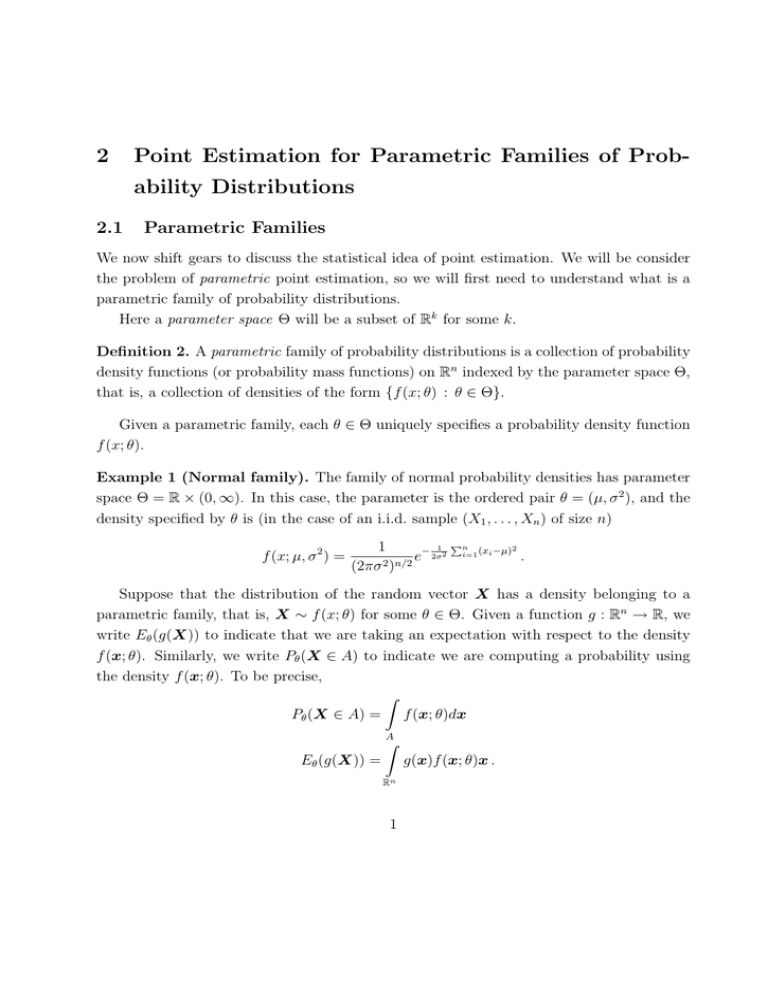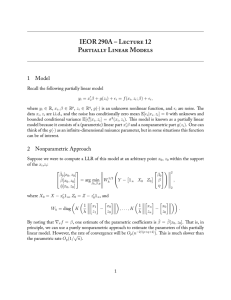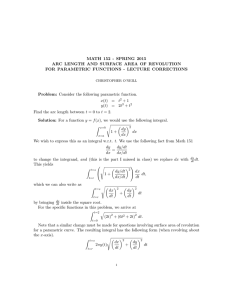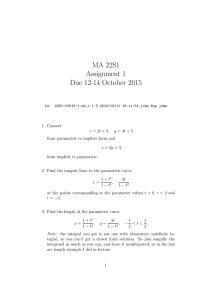2 Point Estimation for Parametric Families of Prob- ability Distributions 2.1
advertisement

2
Point Estimation for Parametric Families of Probability Distributions
2.1
Parametric Families
We now shift gears to discuss the statistical idea of point estimation. We will be consider
the problem of parametric point estimation, so we will first need to understand what is a
parametric family of probability distributions.
Here a parameter space Θ will be a subset of Rk for some k.
Definition 2. A parametric family of probability distributions is a collection of probability
density functions (or probability mass functions) on Rn indexed by the parameter space Θ,
that is, a collection of densities of the form {f (x; θ) : θ ∈ Θ}.
Given a parametric family, each θ ∈ Θ uniquely specifies a probability density function
f (x; θ).
Example 1 (Normal family). The family of normal probability densities has parameter
space Θ = R × (0, ∞). In this case, the parameter is the ordered pair θ = (µ, σ 2 ), and the
density specified by θ is (in the case of an i.i.d. sample (X1 , . . . , Xn ) of size n)
f (x; µ, σ 2 ) =
Pn
2
1
− 12
i=1 (xi −µ) .
2σ
e
2
n/2
(2πσ )
Suppose that the distribution of the random vector X has a density belonging to a
parametric family, that is, X ∼ f (x; θ) for some θ ∈ Θ. Given a function g : Rn → R, we
write Eθ (g(X)) to indicate that we are taking an expectation with respect to the density
f (x; θ). Similarly, we write Pθ (X ∈ A) to indicate we are computing a probability using
the density f (x; θ). To be precise,
Z
Pθ (X ∈ A) = f (x; θ)dx
A
Z
Eθ (g(X)) =
g(x)f (x; θ)x .
Rn
1
A parametric family can have more than one parameterization. For example, we can
parameterize the exponential family by
µ 7→
1 −x/µ
e
1 {x ≥ 0} ,
µ
µ > 0.
Alternatively, it is sometimes parameterized by
λ 7→ λe−λx 1 {x ≥ 0} ,
λ > 0.
When we talk about a parametric family of probability distributions, we should be sure to
specify explicitly which parameterization we are using.
2.2
Statistical Inference
The problem of parametric statistical inference is the following: We observe data X =
(X1 , . . . , Xn ) which has a joint density belonging to some parametric family {f (x; θ) : θ ∈
Θ}. More exactly, the joint density of X is f (x; θ0 ), where θ0 ∈ Θ. We often say that θ0
is the “true” parameter value, in that the observed random variables in fact came from a
distribution having density f (x; θ0 ). The situation is that we do not know the value of θ0 ,
but we would like to infer information about θ0 , based on X.
It is intuitively clear that the data X contains information about the value of θ0 . An
illustrative example is the following:
Example 2. Let X = (X1 , . . . , Xn ) be an i.i.d. sample from a uniform random variable
on the interval [θ0 , θ0 + 1]. Thus, we have the family of densities
f (x; θ) =
n
Y
1 {θ ≤ xi ≤ θ + 1}
i=1
= 1 θ ≤ min xi ≤ max xi ≤ θ + 1 ,
1≤i≤n
1≤i≤n
where θ ∈ R. If we observe min1≤i≤n Xi = a and max1≤i≤n Xi = b, then it must be that
θ0 < a < b < θ0 + 1. In particular, b − 1 < θ0 < a, and we have narrowed down the possible
values of θ0 to those in an interval of length at most 1.
2
2.3
Point Estimation Set-Up
In the context of point estimation, we may be interested in a function τ : Θ → Rp , and we
wish to know τ (θ0 ). Again, we want to make an estimate of τ (θ0 ) based on X.
The notion of a statistic is elementary, but must be stated:
Definition 3. A statistic is a random variable T so that T = t(X1 , X2 , . . . , Xn ) for some
function t : Rn → Rm .
Thus a statistic is any random variable which is a function of the sample (X1 , . . . , Xn ).
Definition 4. An estimator is any statistic T which is used to estimate the fixed vector τ (θ0 ). If we observe (X1 , . . . , Xn ) = (x1 , . . . , xn ) for a (non-random) vector x =
(x1 , . . . , xn ), then the value t(x) is an estimate of τ (θ0 ) when X = x.
Notice that there is not much to the definition of an estimator, as any stupid statistic
def
can qualify. For example, the statistic T = 1 which is always equal to 1 can be claimed
to be an estimator of µ in Example 1. It is, however, a stupid estimator and others are
better.
2.4
Some criterion
We briefly mention here some criterion to decide if an estimator is good. We will not say
much here, but will return to this topic at a later point.
We would like an estimator T to be, “on average” centered around the number we are
trying to estimate, τ (θ0 ).
Definition 5. An estimator T of τ (θ0 ) is called unbiased for τ (θ0 ) if
Eθ0 (T ) = τ (θ0 ) ∀θ0 ∈ Θ .
(1)
We now suppose that for each n, we have a parametric family of densities {f (x1 , . . . , xn ; θ) :
θ ∈ Θ}, where the parameter space Θ does not depend on n. This is the case when
(X1 , . . . , Xn ) is an i.i.d. sample from a parametric family of distributions on R. The following definition applies in this situation.
3
Definition 6. Suppose that we have a sequence of estimators {Tn }∞
n=1 , where Tn is an
estimator based on a sample of size n. Then the sequence {Tn } is consistent of τ (θ0 ) if
Pr
Tn −→ τ (θ0 ) for all θ0 ∈ Θ.
Example 3. Suppose that X1 , X2 , . . . , Xn is a random sample from a parametric family on
R. Suppose that for each θ, the density f (x; θ) has finite variance. Consider the function
of θ given by
τ (θ) = Eθ (X1 ) .
We note that this is indeed a function of θ. Since the distribution of X1 has density f (x; θ),
the expectation of X1 depends on θ. By the Weak Law of Large Numbers, we have that
n
1X
Pr
Xi −→ τ (θ) ,
n i=1
def
and so the sequence of estimators Tn = n−1
Pn
i=1
We will return to these properties later.
4
Xi is consistent for τ (θ).




